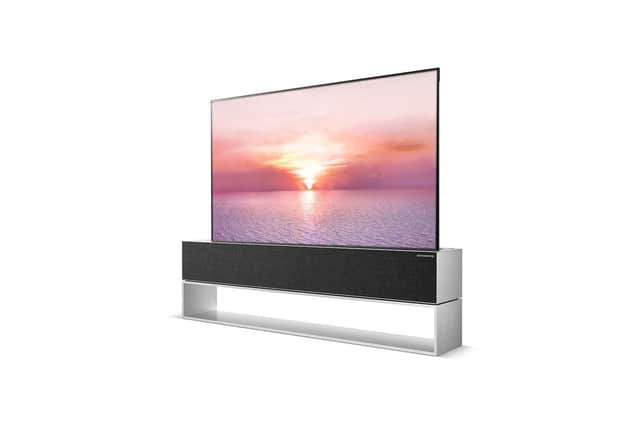Not watching TV right now? Roll it up like a home movie screen


It’s only relatively recently, with the advent of large flat screens, that TV sets have begun to serve as the centrepiece of a room. Before that, manufacturers were at pains to make them blend into the surrounding furniture, with wood veneer cabinets and sometimes folding doors. Anything else would have been considered vulgar.
But as screens increase to near cinema proportions, the idea of packing them out of sight when they’re not in use has gained new traction. That’s where LG’s Signature OLED R set comes in.
Advertisement
Hide AdAdvertisement
Hide AdIts 65-inch screen – that’s nearly 40in bigger than even the largest receivers of the pre-digital era – is just a few millimetres thick and can be rolled up into its base at the click of a button. If you picture one of those retractable screens we used to project our home movies onto in the 1960s, you’ll get the idea. The difference is that they sold for about £25; LG’s new arrival has a price tag that runs into six figures.
It was revealed as a prototype three years ago and it has taken until now to bring it to market. American consumers will be able to buy one this summer and exports to other countries are expected to follow.
The screen behaves like a roll-up garage door, with tension arms on the back to keep it taught. The base unit into which it retracts also houses a four-channel Dolby Atmos sound processor, and the screen allows video games to be played in 4K ultra-high definition. There are no buttons on the front because you can control it with Amazon Alexa voice commands.
Yet it’s not the biggest screen out there – nor is it the only giant TV that attempts to be inconspicuous when turned off. Samsung has taken the opposite approach with a colossal set that measures more than nine feet from corner to corner and which fixes to your wall like a mural. The picture takes up almost the entire screen with virtually no bezel or visible loudspeakers, and when you’re not watching TV you can use it to display a static work of art. Samsung has yet to say how much it will cost, but promises that smaller versions will also be available for those with normal-sized homes and budgets.
Advertisement
Hide AdAdvertisement
Hide AdBoth the Samsung and LG sets can fairly be considered experimental, but there are plenty of similar-sized sets on the high street right now, at sensible-ish prices. An 86-inch smart TV from LG can be had for just over £2,000, but you’ll have to put up with the fact that, size apart, it looks no different to any other set. The same is true for the many 75-inch models, from LG, Samsung, Sony and Philips, at prices starting from £1,000.
LG claims to lead the field in outsize TVs with a proprietary technology called Nanocell – a process that uses extremely small particles which filter out impurities to deliver cleaner, sharper pictures. But in truth, image quality depends on the video processor as much as the screen, and for that reason no two models are exactly alike. So it’s important to see a shop demonstration before you choose, and even then you will need to make allowances for the differences in ambient light.
And of course it’s no use buying an enormous screen if you’re going to be watching it from only a few feet away. It will strain your eyes so much that you’ll wish you really could roll it up and put it away.
Support The Yorkshire Post and become a subscriber today. Your subscription will help us to continue to bring quality news to the people of Yorkshire. In return, you’ll see fewer ads on site, get free access to our app and receive exclusive members-only offers. Click here to subscribe.
Comment Guidelines
National World encourages reader discussion on our stories. User feedback, insights and back-and-forth exchanges add a rich layer of context to reporting. Please review our Community Guidelines before commenting.